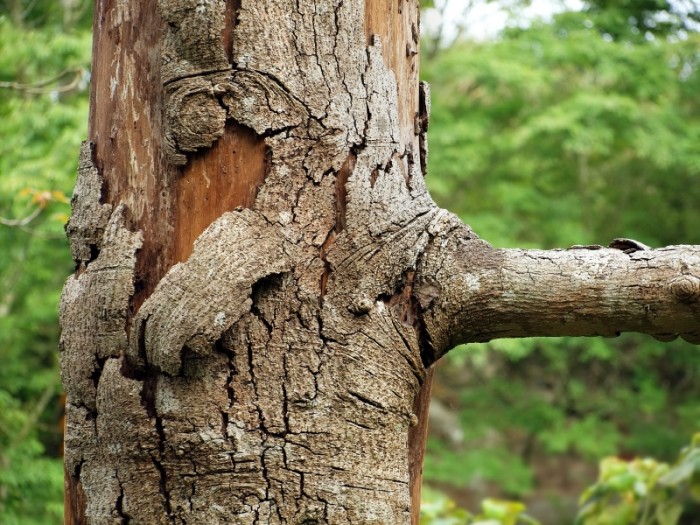
One of the most common and serious types of disease on trees is tree cankers. These are areas of bark that have died on the trunks or branches of trees. There are several things that could cause the death of the bark in a particular area, such as physical damage caused by impact, bacteria, or fungi. Normally, pathogens such as bacteria or fungi are unable to penetrate the bark, but if the bark tissue is damaged by injury, infection is more likely. One serious consequence of this problem is known as girdling, which can cause the death of branches of the plant above the canker. The entire tree can be killed if the canker is somewhere on the trunk.
Cankers can also pose a problem in another way. While cankers that result from physical injury may not kill the tree, the area around the canker can be weakened by various wood-rotting organisms. If this weakens branches, they can pose a hazard during rain or wind storms. For this reason, it’s important to stop cankers from developing on trees and to properly treat them when they do appear.
Types of Cankers
Wound cankers, or annual cankers, generally occur near the base of a tree trunk. They most often result from abrasion by lawnmowers or other yard maintenance equipment. If this abrasion continues, the result can be girdling and the death of the plant. Placing barriers around the tree can prevent this type of injury. As an alternative to grass around the tree, homeowners can place a circle of gravel or bark mulch around the base. This will eliminate the necessity of mowing in that area and possibly damaging the tree.
There are several types of fungi that can cause perennial, target-shaped cankers in deciduous trees. The infections happen either because of bark injuries or near the junction of live and dead tree branches. The fungus will grow gradually in the bark over fall and winter. You can recognize these cankers in the growing season by the bull’s-eye-like growth rings of the fungus and the tree as the tree tries to respond to the infection.
Diffuse cankers are an extremely shallow type of canker in which the fungi grows faster than the tree’s ability to respond. Often, the bark on the margins of the canker will be somewhat discolored. Unfortunately, diffuse cankers, if left untreated, are generally lethal. For this reason, branches that have been infected should be immediately removed.
Canker Management
While there are some differences from tree to tree in how one would go about reducing the damage caused by cankers or preventing them entirely, most management practices will adhere to the following points.
Maintaining the overall health and vitality of the tree is one of the best ways to reduce the frequency and severity of cankers. Trees that are under stress and in poor health are more prone to disease. Adequate watering can reduce the most significant stress factor that trees face, particularly those in urban conditions. Avoid planting trees in poor soil conditions or in locations that limit root growth, such as near walls or sidewalks. The health of the tree will also be improved by fertilization in either the early spring or late fall. Canker problems can also be reduced with regular pruning. It’s best to prune either early in the spring or after leaf expansion in the summer. Damaged or dead branches can abrade against other branches, causing injuries, so remove them.
When it comes to pruning, do as little damage as possible. Make sure that there are no stubs left and that the wound from the pruning is no bigger than necessary. These wounds should close without treatment, but a shellac can be used if necessary. When a canker is on the trunk of the tree and found early enough, it may be possible to excise the canker. The key is to make sure that you cut far enough into healthy bark to remove all of the canker from the tree. It is also vital to avoid re-infecting the tree with the canker. This is done by thoroughly sterilizing your pruning instruments for several minutes after every cut by dipping them in a sterilizing solution consisting of 70% alcohol, 20% water, and 10% bleach. If the canker is greater than half the size of the circumference of the trunk, it may be impossible to save the tree and it may have to be removed. If so, it should be replaced with a tree that is less susceptible to canker problems. Aspen, willow, and poplar are among the very worst trees when it comes to cankers.
- Perennial Canker
- Canker Diseases of Trees
- Bacterial Canker
- Citrus Canker FAQ
- Cankers on Western Quaking Aspen
- How to Cure Canker Fungus on an Apple Tree
- Bacterial Canker
- Canker
- Bacterial Canker
- Canker and Galls
- Canker
- Cankers of Hardwood Deciduous Trees
- Canker Diseases
- Thousand Cankers Disease
- Fungal Cankers of Trees
